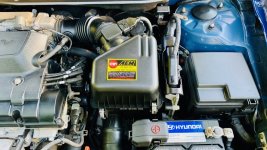Quick question, Ive noticed on both of the Hyundais 2009 Elantra and 2013 Sonata, I see a "DO NOT REMOVE" printed on this air box intake secondary filter upstream of the main filter on the lid. So now i'm curious as to why  .. Whats is its purpose?
.. Whats is its purpose?  Is this just to catch very very fine particles? I cant replace it even if i wanted to because it molded into the top lid of the air box lol. But can i remove it for more air flow?
Is this just to catch very very fine particles? I cant replace it even if i wanted to because it molded into the top lid of the air box lol. But can i remove it for more air flow?  I did a test yesterday with a AEM dry flow drop in, vs regular air filter, and the results are about even, BUT maybe this secondary filter is actually causing a "restriction", as it is upstream the main air filter in the intake.... I'm thinking it EPA related or something, but it just a wild guess.
I did a test yesterday with a AEM dry flow drop in, vs regular air filter, and the results are about even, BUT maybe this secondary filter is actually causing a "restriction", as it is upstream the main air filter in the intake.... I'm thinking it EPA related or something, but it just a wild guess.
I'm probably going to leave it, but the curiosity is getting to me on why it has two air filters a replaceable one, and the one that molded into the top lid?
Thanks!



I'm probably going to leave it, but the curiosity is getting to me on why it has two air filters a replaceable one, and the one that molded into the top lid?
Thanks!

